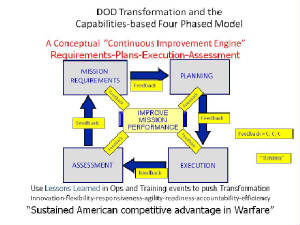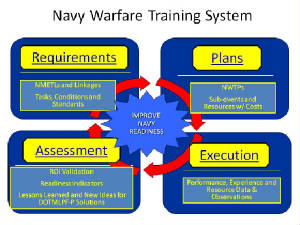|
|
5. Adopt the process. Understand the Four-phased continuous improvement
process of Training Transformation (T2) through the Joint Training System & Navy Warfare Training System: Requirements-Plans-Execution
and Assessment. DOD’s Training Transformation (T2) is running on a conceptual “continuous improvement engine” fueled by Lessons Learned and other ideas generated from training and operating events, as well as projected future mission analysis. This transformation engine operates continuously where all of its phases are being conducted simultaneously: METLs are continuously refined, future planning is happening in the midst of execution, and assessments are updated and reported near-real time. This concept represents the foundation of the Capabilities-based system of systems.  The Navy Warfare Training System (Figure 5) modeled on the Joint Training System (JTS) provides a systematic four-phased approach to transforming Fleet training and operations.
Commander’s employ the NWTS which identifies mission-based capability needs (NMETLs) in the Requirements Phase; identifies and codifies prioritized training requirements in a progressive and synchronized Navy Warfare Training Plan (NWTP- the curriculum) in the Plans Phase; conducts, evaluates, and reports mission focused, effective and efficient training in the Execution Phase; and gathers and analyzes the collective results of Navy training and performance in the Assessment Phase. Evidenced-based Management
The NWTS represents an interlocking series of disciplined, logical, and repeatable processes designed to continuously improve Fleet training, Navy performance, and mission readiness. In addition to building a Fleet Response Training Plan (FRTP), NWTS also has incorporated the inception of the Readiness Cost Engine for Training (RCE-T), an activity-based cost system designed to capture the costs for achieving added value to mission performance. Through detailed analysis of training plans and resource utilization, significant conclusions can point to the actual costs incurred to gain additional confidence for subsequent mission performance. And once we can accurately model training capability costs, we can then enhance the system to model and predict costs and projected values of any DOTMLPF-P system enhancement to overall mission readiness and performance. Linking “Training and Readiness”
Dr. Laura Junor, the Defense Readiness Reporting System director and scientific adviser for the Office of the Secretary of Defense Readiness Programming and Assessment Division, wrote in Joint Forces Quarterly that DRRS is shifting the focus of force managers from tracking unit readiness to understanding force capabilities.[19] One of the major goals for the Training Transformation is to link training with readiness. The key phrases “Mission Rehearsal” and “Training Transparency” reverberate throughout the readiness through training linkages. DOD Directives clearly call for training in conditions resembling, as close as possible, the circumstances and conditions a force will actually face in its future mission performance.
And since we are NMETL-based, our training standards can be set to reflect our mission performance standards- and often they can be the same! So now, in our mission rehearsal efforts, commanders will learn how to monitor their NMETs’ processes as well as their outcomes and products. As leaders focus on attaining “efficient excellence,” their command perspective- from tactical to operational to strategic- will be refined as they apply this systems-thinking approach to building mission readiness.
The DRRS Theory as “Confidence” DRRS depends on expressing MET readiness in a manner that we can accumulate into Total Readiness. Commanders must assess the readiness for their organizations to meet performance expectations for each NMET for every assigned mission. Therefore, a need exists for a global system or process to maintain the “Expected Performance Status” of every NMET. One way to say that might be “Readiness is an expression of ‘Confidence’ that when called on for a mission, a unit will perform its mission-essential tasks to standards under the given conditions.” Anything we do to increase that level of performance confidence, increases readiness: Training, Maintenance, more qualified or experienced Personnel, better Doctrine… The improved performance and confidence can come along any “DOTMLPF-P” line. A sample Cruiser (CG) CO’s NMET evaluation for DRRS follows: Task: NTA 3.2.2 Attack enemy land targets. CO’s Assessment: Yes (Green) Based on the following: - Ship recently demonstrated ability to meet all standards—and those standards are traceable to COCOM mission requirements. - No new DOTMLPF-P to incorporate. - No changes to “METT-TC” or watch teams. (Simplifies mission rehearsal.) - Task performance history shows continual success. - Moreover, all ESORTS[20] categories (Personnel, Equipment, Supply, Ordnance, Training and Facilities) show no degradations affecting mission task performance. Note that NMET standards (Mission performance requirements) drive resource (or DOTMLPF-P systems) requirements which then lead to Human Performance Requirements!
Go to Step 6 "Refine your Coup d'oeil" |
Enter supporting content here
